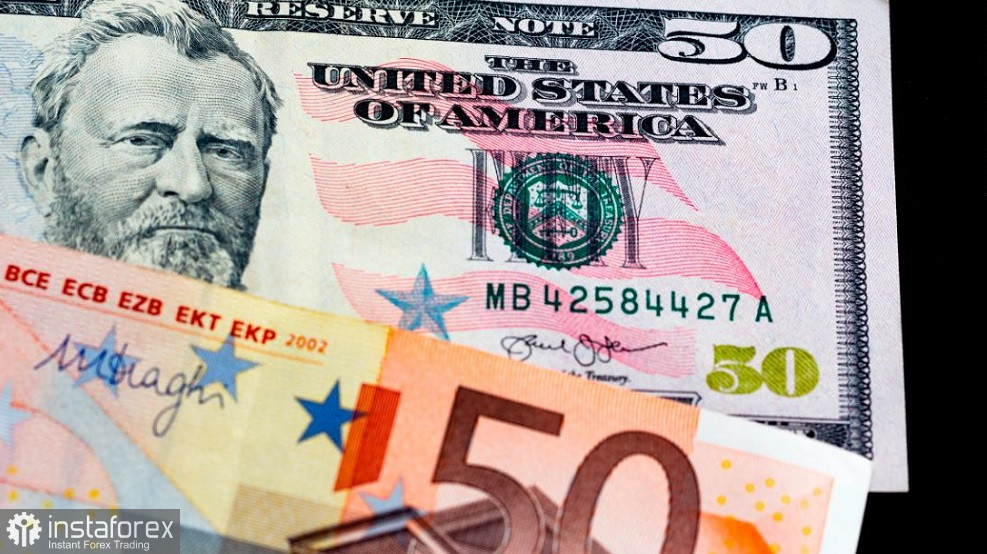The euro-dollar pair made two attempts this week to break through the support level of 1.0730 (the lower line of the Bollinger Bands on the D1 timeframe) but in vain. Sellers took profits in this price range, thereby extinguishing the downward impulse. Had they surpassed the 1.0730 target, traders would have paved the way towards the 6th figure, with the main target located at 1.0620 (the middle line of the Bollinger Bands on the monthly timeframe). However, this was not to be. After two unsuccessful attempts (yesterday and the day before), EUR/USD sellers gave up. Buyers took the initiative, organizing a rather sluggish but still corrective pullback.

Nevertheless, the fact remains: the 6th figure proved to be too much for the bears. At least they failed to conquer this price area forcefully. This raises a logical question: how strong are the positions of the U.S. dollar? And, in general, can we trust the downward trend?
These questions, as they say, come with a caveat. On the one hand, the euro is currently unable to turn the situation in its favor. Besides the disparity in growth rates, there is also a gap in the statements of central bank representatives. On the other hand, the potential of the dollar is limited. Members of the Federal Reserve discuss only the timing of rate cuts, not the advisability of this step. This means that the potential threat to the downward trend remains.
To recap, the U.S. GDP in the fourth quarter of last year grew by 3.3% YoY (with a forecast of 2.9%). The third quarter also ended positively, with the U.S. economy growing by 4.9%. Meanwhile, the GDP of the eurozone in the fourth quarter of 2023 remained at the level of the previous quarter—at 0.0% QoQ. In annual terms, the eurozone economy increased by only 0.1%. The "locomotive of the European economy" also broke down, as German GDP contracted by 0.3% compared to the previous quarter.
As for the rhetoric of the Federal Reserve and the European Central Bank, the scales have also begun to tip in favor of the greenback. Following the December meeting, the markets chose March 2024 as the starting point for the monetary policy easing. At the end of last year, the likelihood of a rate cut at the March meeting approached 80%. However, in January, dovish expectations began to dissipate—the overall inflation in the U.S. in December and the strong Nonfarm Payrolls finally dispelled the hopes of EUR/USD buyers.
As of writing, the probability of a rate cut in March has decreased to 17%. This was contributed to by some Federal Reserve members who called for caution in easing monetary policy. For example, Cleveland Fed President Loretta Mester warned against a sharp and premature rate cut. She cautioned that inflation "may be more persistent than expected," and wage growth is still too high to achieve the target level.
In an interview with CBS, Fed Chair Jerome Powell again refuted March prospects, indicating that further rate decisions will depend on incoming data. Some other Fed representatives (including Christopher Waller) have also toughened their rhetoric, advocating for maintaining the status quo in the near future.
Not too long ago, the markets were confident that the Federal Reserve would begin easing the monetary policy stance in March. Now, however, this scenario is completely ruled out, and prospects for May are in question. The growth of the U.S. economy, high rates of job creation in the non-agricultural sector of the U.S., and an acceleration in average wage growth, allow the U.S. regulator to hold its defense at least until June. And if needed, possibly until the autumn meetings.
Therefore, the very prospect of upcoming easing of the monetary policy stance (which is likely to happen within the framework of 2024) is not an existential problem for the greenback. The Federal Reserve has revised its plans and postponed the rate cut from March to an open-ended date. This is sufficient for the dollar to continue strengthening its positions in the medium term, especially against the backdrop of the softened rhetoric of the European Central Bank (ECB).
Representatives of the ECB have recently made it clear that they do not intend to delay the easing of monetary policy – for instance, Christine Lagarde recently stated that everything would depend on the dynamics of wages. Later, this position was supported by Klaas Knot, who referred to wages as the "last piece of the puzzle."
Thus, there are no significant prerequisites for a trend reversal at the moment. The downward trend of EUR/USD is on pause, but speaking of sustainable growth is not warranted now, as the fundamental background does not clearly support it. In terms of trading decisions, there are two options – either take a wait-and-see position or open short positions from current levels with 1.0730 (the lower line of the Bollinger Bands on the D1 timeframe) as the initial target.





















